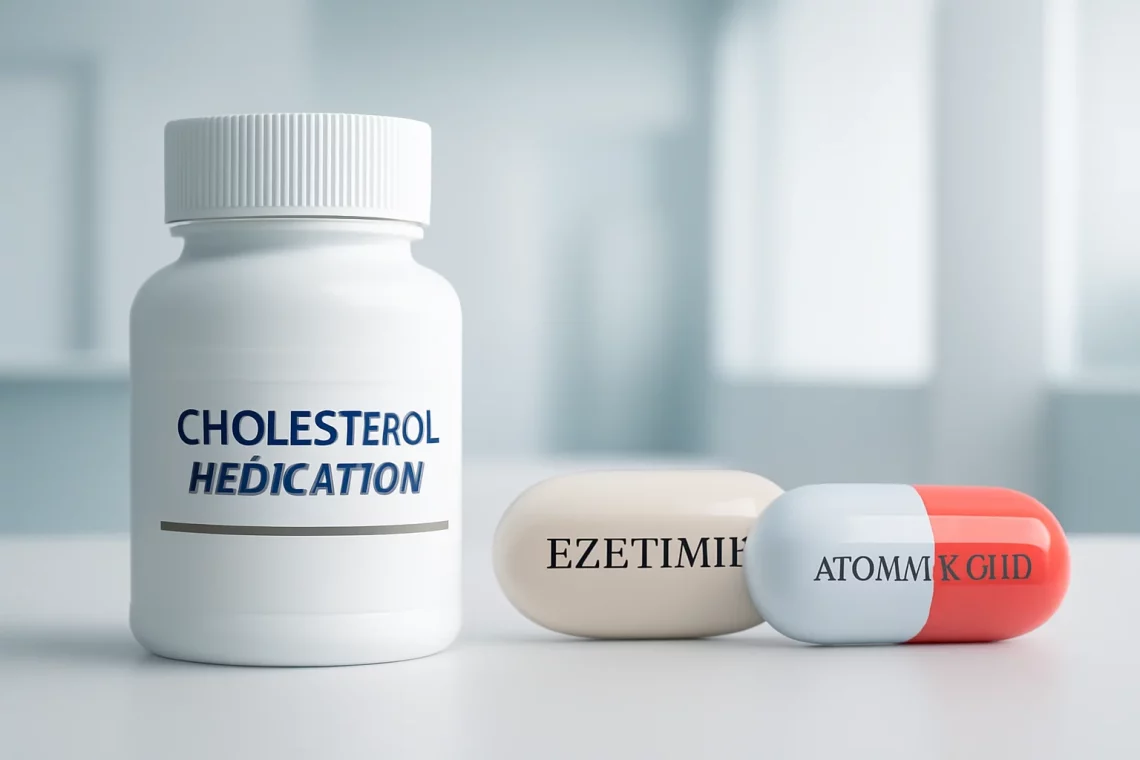
Ezetimibe vs Atorvastatin: Which Cholesterol Medication is Right for You?
Ezetimibe and atorvastatin are two widely used medications that play a crucial role in managing cholesterol levels and reducing the risk of cardiovascular diseases. As heart disease remains a leading cause of morbidity and mortality worldwide, the importance of effective cholesterol-lowering strategies cannot be overstated. Both medications target lipid metabolism but through different mechanisms, which can lead to varying effects and outcomes for patients. Understanding the distinctions between these two drugs is essential for both healthcare professionals and patients alike, as it enables informed decisions regarding treatment options.
Ezetimibe is primarily known for its ability to inhibit the absorption of cholesterol in the intestines, while atorvastatin is classified as a statin, which works by inhibiting HMG-CoA reductase, an enzyme involved in cholesterol synthesis in the liver. This fundamental difference in action highlights the need for personalized medical approaches tailored to individual patient profiles, including their cholesterol levels, overall health status, and potential drug interactions. The growing body of evidence surrounding these medications also underscores their respective roles in contemporary treatment regimens. As we delve deeper into their properties, benefits, and considerations, it becomes increasingly clear that both ezetimibe and atorvastatin have significant roles to play in the fight against dyslipidemia and its associated complications.
Ezetimibe: Mechanism of Action and Benefits
Ezetimibe, marketed under various brand names, has gained recognition for its unique mechanism of action. Unlike traditional statins, which work primarily in the liver, ezetimibe acts at the intestinal level. Specifically, it inhibits the Niemann-Pick C1-like 1 (NPC1L1) protein, which is responsible for the uptake of cholesterol from the intestines into the bloodstream. This inhibition leads to a decrease in the overall absorption of dietary cholesterol, thereby lowering plasma cholesterol levels.
One of the significant benefits of ezetimibe is its ability to be used in conjunction with statins. For patients who do not achieve their target cholesterol levels with statin therapy alone, adding ezetimibe can provide an additional reduction in low-density lipoprotein (LDL) cholesterol. This combination therapy is particularly useful for patients at high risk of cardiovascular events, as it can enhance the lipid-lowering effect without significantly increasing the risk of adverse side effects.
Moreover, ezetimibe is generally well-tolerated, with a side effect profile that is less severe than that of statins. Common side effects may include gastrointestinal symptoms such as diarrhea or abdominal pain, but these are typically mild and transient. The favorable tolerability of ezetimibe makes it an attractive option for patients who may experience muscle-related side effects from statins, allowing them to continue effective cholesterol management without significant discomfort.
In clinical studies, ezetimibe has shown a consistent ability to reduce LDL cholesterol levels significantly. Additionally, it has been associated with improved outcomes in terms of cardiovascular health. For instance, patients taking ezetimibe have demonstrated a reduced risk of major cardiovascular events compared to those not receiving the drug. This evidence supports the notion that ezetimibe can play a vital role in comprehensive cardiovascular risk management.
Atorvastatin: Role in Cholesterol Management
Atorvastatin is one of the most widely prescribed statins and is well-known for its efficacy in lowering LDL cholesterol. As a member of the statin family, atorvastatin works by inhibiting the enzyme HMG-CoA reductase, which is a critical step in the biosynthesis of cholesterol in the liver. By reducing cholesterol production, atorvastatin prompts the liver to increase the uptake of LDL cholesterol from the bloodstream, thereby lowering overall blood cholesterol levels.
The benefits of atorvastatin extend beyond cholesterol reduction. Numerous studies have demonstrated that atorvastatin not only lowers LDL cholesterol but also has favorable effects on other lipid parameters, such as increasing high-density lipoprotein (HDL) cholesterol and decreasing triglycerides. This comprehensive lipid modulation is particularly important for patients with mixed dyslipidemia.
Atorvastatin is also associated with additional cardiovascular protective effects that are not solely attributed to its lipid-lowering capabilities. Research indicates that statins may have pleiotropic effects, including anti-inflammatory properties and stabilization of atherosclerotic plaques. As a result, patients taking atorvastatin may experience a reduced risk of heart attacks, strokes, and other cardiovascular events, making it a cornerstone in the management of patients with established cardiovascular disease or those at high risk.
However, like all medications, atorvastatin is not without potential side effects. Some patients may experience muscle pain, weakness, or an increased risk of developing diabetes. It is essential for healthcare providers to monitor patients regularly and adjust doses as necessary to minimize these risks. Despite these concerns, the overall benefits of atorvastatin in reducing cardiovascular morbidity and mortality often outweigh the potential side effects, especially when used judiciously and with proper patient education.
Comparative Effectiveness of Ezetimibe and Atorvastatin
When comparing the effectiveness of ezetimibe and atorvastatin, it is crucial to consider the specific clinical context and patient needs. Ezetimibe is primarily focused on reducing intestinal cholesterol absorption, while atorvastatin reduces cholesterol production in the liver. This fundamental distinction leads to different clinical applications for each medication.
For patients with primary hypercholesterolemia who require significant LDL cholesterol reduction, atorvastatin is often the first-line treatment due to its potent efficacy. Studies have shown that atorvastatin can achieve greater reductions in LDL cholesterol compared to ezetimibe alone. However, for patients who are statin-intolerant or who experience side effects from statins, ezetimibe can serve as an effective alternative or adjunct therapy.
In patients already on statin therapy who still have elevated LDL cholesterol levels, the addition of ezetimibe can provide further improvement in lipid profiles. This combination approach has been validated in various clinical trials, demonstrating that the use of ezetimibe alongside atorvastatin leads to superior cholesterol management compared to either agent alone.
Moreover, the choice between ezetimibe and atorvastatin may also depend on the patient’s overall cardiovascular risk profile and other comorbid conditions. Healthcare providers must carefully assess each patient’s unique situation, including their lipid levels, history of cardiovascular events, and tolerance of medications, to determine the most appropriate treatment strategy.
Both ezetimibe and atorvastatin have robust evidence supporting their use, and in many cases, they may even be used in tandem to achieve optimal cholesterol management. This personalized approach ensures that patients receive the most effective therapy tailored to their specific needs, ultimately leading to better health outcomes.
Conclusion
In summary, both ezetimibe and atorvastatin are effective agents in the management of cholesterol levels and cardiovascular risk. Ezetimibe’s unique mechanism of action makes it a valuable option for patients who require additional cholesterol-lowering therapy or who cannot tolerate statins. In contrast, atorvastatin remains a cornerstone in lipid management due to its potent LDL cholesterol-lowering effect and additional cardiovascular benefits.
The decision to use either medication should be made collaboratively between healthcare providers and patients, considering individual health profiles, treatment goals, and potential side effects. As the landscape of lipid management continues to evolve, ongoing research and clinical experience will further refine our understanding of how to best utilize these medications to improve patient outcomes.
**Disclaimer:** This article is for informational purposes only and does not constitute medical advice. Always consult your healthcare provider for personalized recommendations and guidance regarding any health issues or medication use.




